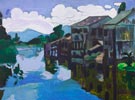十
在那些肖像作品中,和充满感性的嘴唇相对应的是目光的冷漠、迷失和疏离,拒人千里。嘴唇在此是一道屏障,或者是一条通往肖像之谜的小径。在观者的眼中,俸正杰的作品表达着当今世界的诱人的,同时又是异化的状态;一个灵魂寻求与另一个灵魂的接触,也许是虚假地,也许是真诚地,往往带有绝望的孤独感,伴随着深深的愤世嫉俗,疏离于人性的根本:即慷慨地没有功利色彩地对他人付出的能力。……
... Portraits in which to the sensuality of the lips correspond a cold feeling, the looseness and oddity of a glance that leaves the spectators with no words. Feng Zhengjie’s works remind to the visitors that the world of today is seductive and alien at the same time, that a soul looking for a contact with another, falsely or generously, often with desperate loneliness, is accompanied by cynicism, by a detachment from whatever is human that is the ability of conceding ourselves to the others with generosity.
实际上,我相信如今没有任何艺术家能比俸正杰更好地迅速表现出他的国家在全球化的和暴富的冲击下,几千年的传统经受了怎样的动荡。他的作品强调了物质生活质量和传统精神价值之间的隔阂,生活方式和西方世界非常相似,但是对一种更舒适的生活的追求加诸在无节制的消费主义之上,更突出了年轻一代的困惑和迷茫:在他们争得与世界关系的那一刻,仿佛失去了自己的灵魂。……
I believe there is no artist that can nowadays best describe the challenge and process through which Chinese traditions underwent while experiencing the consequences of these last years’ globalization and new richness. Feng Zhengjie’s works underline the void, which has been created between the quality of material life and the traditional spiritual values. In China, today, life styles are very similar to those of the Western world, but there is a sort of distrainment due to the fast adaptation to wealth and consumerism, something very distant to be able to get used to, especially for such an old civilization, which seem now losing its soul…
俸正杰观察着每天的生活和他与外部世界的关系,通过自己的作品提出了问题,再为问题提供了假设答案。研究俸正杰的作品首先意味着,重新以批判的眼光来审视经验和习惯带来的舒适做法。他的作品不能轻易地被归结为流行艺术,或者是Kitsch,当然更不能划为中国传统艺术。他的作品让观者给自己提出许多问题,因为他的作品不是一个纯美学的现实,而是在艺术创作活动中加入了知识和道德元素,它们入画后转回来在形成它们的社会中再次发挥作用,带来新形式的感觉、概念,但愿还有行为方式。
Feng Zhengjie, through his work, advances questions and gives possible answers comparing himself with the daily life through the complex relations that he creates with the outside world. To relate with Feng Zhengjie’s works means, first of all to critically reconsider the comfortable certainties derived from experience and habit. In fact, it is not so easy a classification of his paintings in the schemes of pop art, kitch and traditional Chinese painting. They are works that force the viewer to make many questions because his painting is not a pure aesthetic fact, it’s rather an activity that involves, in its development, intellectual and ethic components that act in the social world, in which it is produced and, at the same time, they introduce new forms of sensitivity, perceptions and, we wish, behavior.
——洛伦佐· 萨索利·德·彼安奇:《俸正杰》(2005年)
Lorenzo Sassoli de Bianchi, Feng Zhengjie, 2005
十一
重要的是俸正杰已经发展出一种依据当代的视觉经验建立起来的图像方式。他们看起来像那些夸张的照片构图和造型,但是却是用人工的方式来想象和构造出来的。在这些创作的过程中,艺术家放弃了道德判断。如果艳俗艺术以反讽为精神核心的,那么俸正杰的精神核心是通过借用商业文化和大众文化的方式发展出一种新的审美趣味和图像处理方式,通过模仿、仿造和改写,揭示出当代商业图像的生产机制。这样他也就必然触及到了这个图像化生存时代的精神本质。特别在肖像系列中,艺术家创造了一系列脱胎于流行文化和大众文化的当代精神肖像。在这里,虽然道德判断消失了,但是其图像的意义却以一种少有的当代性面貌呈现出来。
It is important that Feng Zhengjie has developed a form of image according to contemporary visual experience. The works look like exaggerated photographs related to fashion, but are imagined and constructed artificially. During the period of creation, the artist abandons ethical judgment. If Gaudy Art is spiritually centred on irony, then Feng Zhengjie’s spiritual core is to develop a new aesthetic interest and means of processing images by borrowing from commercial culture and popular culture, to achieve a new form of contemporary commercial images through imitation, counterfeit and rewriting. So he inevitably touches with the spiritual essence of this era of pictorial subsistence. Especially in the Portrait Series, the artist creates a series of contemporary spiritual portraits which were born out of popular, mass culture. Although the ethical judgment has disappeared, its pictorial meaning unfolds with an unwonted visage of modernism.
——皮力:《超越艳俗》(2005年)
Pi Li, Transcending Meretriciousness, 2005
十二
俸正杰对颜色的使用给人留下了深刻的印象,这同时也赋予了其作品以力量。他使用的色调主要是红色和绿色,并在此两种颜色的基础上进行深浅变化,如同在过去和现在,在历史与现实之间建立起无数联系。除了偏爱这两种颜色外,俸正杰还告诉我,其实红绿两色在中国是最常被采用的:“中国是红色和绿色的”。只要看看周围你就能明白:红墙绿顶的房子,绿色的翡翠,红色的灯笼,绿色的茶;另外在中国人的思想意识中,婚礼是红色的,红色象征着好兆头……给人的感觉是,这个国家真的是双色的。俸正杰使用了这两种颜色,但又将它们变得更为艳丽,更为强烈,甚至可以说是更为辛辣(将其用到了极至)。在他的现代油画作品中,两种颜色的使用达到了电视和广告宣传画中的效果:红色更加鲜明,更趋向于艳粉;绿色则变得更有潜在力,冷冷的颜色就像翠绿的宝石,绿水有时也会变成蓝色。
Really important and impressive is in fact the study of colors that gives strength to his canvas. The most used variations are those of the red and the green, and these assorted shadows determinate a further relation between past and present, historical references and contemporary aspects. A part his personal taste, the artist explains me how much these two colors have been largely used in China. “China is red and green” and, this is obvious when looking around: old buildings with red walls and green roofs, jades, lanterns, tea, the ideology, the red of weddings and good luck auspicious…it looks like this country is bi-chromatic. Feng Zhengjie uses these colors but makes them fluorescent, electric, almost acid. These works are contemporary oils, where the red, taking inspiration from television and advertisings, is more and more lighted and tends to fuchsia, while the green is virtual, cold as an emerald, and from water-green sometimes it changes into blue.
——Eleonora Battiston:《皮肤之下,目光之外——俸正杰的肖像作品》
Eleonora Battiston, UNDER THE SKIN, BEYOND THE EYES - FENG ZHENGJIE’S PORTRAITS
十三
俸正杰不是在模仿现实,实际上,他不相信这个人人都生活其中的现实,现实不过是别人的一种假设之后的结果,画家越来越肯定的是自己对现实的建设和创造,这就是说,制造没有存在过的假像成为今天工作的内容。人们真的热中于看到艺术家告诉我们对现实的看法吗?不尽然。相反,正是层出不穷的假像构成了这个世界的变化,而正是由假像构成的变化,使我们认识到了今天与过去的不同,认识到了问题的精彩。
如果有人要问:我们今天是否还有必要揭示真实,或者发现事物的本质?艺术家的回答是:这个鲜明的假像难道还不够吗?
Feng is not creating any kind of reality, this is all false, and yet in the viewer’s awed response to the paintings-to its iconic beauty, a form of reality is assumed.
In conclusion, we need to go back to the issue of ‘truth’ seeking that had so concerned Feng prior to his ‘deceptive phase’. We need to ask whether it is actually necessary to search for these answers-to search for the truth? In response, the artist may reply: is this beautiful deception not enough? This deception is the only answer, therefore we must assume that all we see cannot be taken at face value and that we are surrounded every day by mere images and falsity.
——吕澎:《鲜明的假像——关于俸正杰的艺术》(2006年)
Lv Peng, Feng Zhengjie - A Beautiful Deception, 2006




